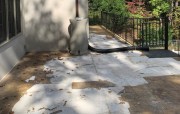Stego Industries
Proper installation of vapor barriers requires sealing all seams…
Stego Industries
Proper installation of vapor barriers requires sealing all seams…
But a quality, optimally graded concrete with minimal paste content suitable to hard trowel finishability will shrink less, curl less, and shed less water in less time than a strength-driven version. The hallmark of such a low-shrinkage concrete mix is optimization of aggregates and minimization of water, based on the principle that strength alone should not govern a high performance slab on ground.
A quality, low-shrinkage concrete mixture with an initial slump of little more than 1 inch is eminently finishable. While the slump test is not a precise measurement of actual water weight in the mix it is useful for comparative purposes. One inch of slump is equivalent to about 10 pounds of water. A fine-tuned initial slump, measured at the truck discharge, is accomplished by holding back design batch water at the plant and restoring it incrementally in the field.
Generally, a water-cement ratio of 0.40 will fulfill the chemical hydration process. That amount of water does not, however, satisfy the thirst for sufficient bleedwater to produce a hard-trowelled finish. After the concrete has stiffened enough to support floating operations, excess water will gradually escape via capillarity and evaporation, partially in the form of unused bleedwater. This water is predominantly overflow, which exacerbates drying shrinkage (volume reduction) as it leaves. Water management is furthered in the field with truck-dosage of a first generation superplasticizer, only, to achieve an elevated final slump consistent with laser screed placeability.
In contrast to a traditional two-aggregate mix (often gap-graded), slab concrete designed for the lowest shrinkage is custom-blended using four aggregates (which are chemically inert), typically including added 11/2-inch top-sized and 3/8-inch intermediate aggregate, thereby reducing surface area and packing interstitial spaces that would otherwise be choked with chemically active paste (cement and water). This is readily accomplished without compromising the target compressive and flexural strengths.
Most of today’s big-box industrial floors are constructed of conventional cast-in-place plain concrete. Mitigation of drying-shrinkage-related curling and cracking is imperative for a successful floor. An additional benefit of the low-shrinkage strategy is more rapid drying for areas that will be covered with modern impermeable floor coverings. Given the accelerated project construction schedules, time is dear.
The first and perhaps only line of defense against an abundance of intrinsic moisture outflow is minimizing mixing water, a principle underlying the low-shrinkage concept, a low-water strategy that has proven efficient and economical since it dramatically reduces cement content (less water at the same w/c equals less cement). This mix simultaneously serves sustainability standards while achieving the highest serviceability characteristics and the lowest maintenance expenditures.
Moisture outflow from the concrete mass is not the only source of vapor emissions from an unprotected slab. Culprits include:
These factors, perhaps not contemplated in the concept of separating floor from membrane with a porous fill layer, are rooted in capitulation to a perceived inevitability of water-laden generic concrete for slabs-on-ground. Accordingly, for slab areas designated to receive adhered floor coverings, resolving the issue of vapor-retarder selection, position, and installation is clear:
One need but witness one moisture emissions debacle to reach the conviction that a properly installed quality vapor-retarding membrane positioned directly beneath a low-shrinkage concrete slab-on-ground is the inevitable choice.
Ed Finkel, Berkeley Heights, N.J., is a consulting structural engineer specializing in concrete slab on ground. He is a fellow of both ACI and ASCE.


